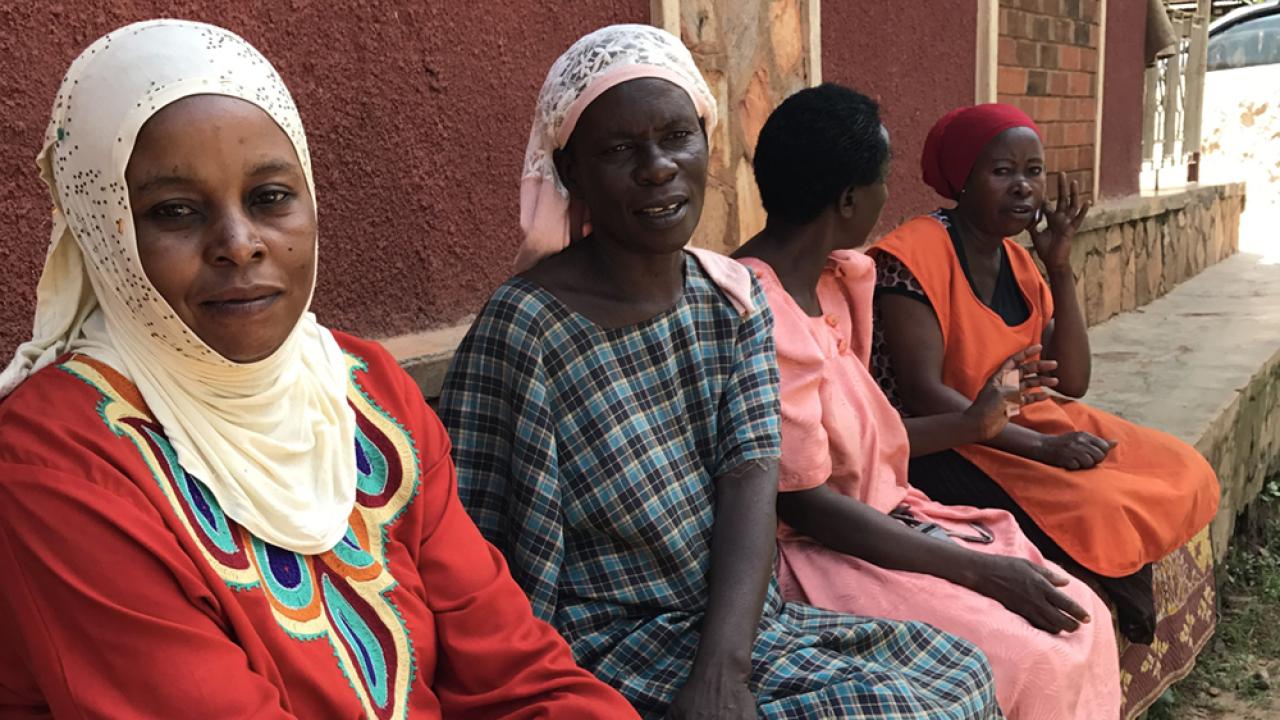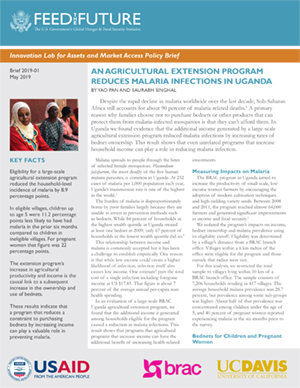
Despite the rapid decline in malaria worldwide over the last decade, Sub-Saharan Africa still accounts for about 90 percent of malaria-related deaths.[1] A primary reason why families choose not to purchase bednets or other products that can protect them from malaria-infected mosquitoes is that they can’t afford them.
In Uganda we found evidence that the additional income generated by a large-scale agricultural extension program reduced malaria infections by increasing rates of bednet ownership. This result shows that even unrelated programs that increase household income can play a role in reducing malaria infection.
Highlights
- Eligibility for a large-scale agricultural extension program reduced the household-level incidence of malaria by 8.9 percentage points.
- In eligible villages, children up to age 5 were 11.2 percentage points less likely to have had malaria in the prior six months compared to children in ineligible villages. For pregnant women that figure was 22 percentage points.
- The extension program’s increase in agricultural productivity and income is the causal link to a subsequent increase in the ownership and use of bednets.
- These results indicate that a program that reduces a constraint to purchasing bednets by increasing income can play a valuable role in preventing malaria.
Malaria spreads to people through the bites of infected female mosquitoes. Plasmodium falciparum, the most deadly of the five human malaria parasites, is common in Uganda. At 232 cases of malaria per 1,000 population each year, Uganda’s transmission rate is one of the highest in the world.[2]
The burden of malaria is disproportionately borne by poor families largely because they are unable to invest in prevention methods such as bednets. While 84 percent of households in the highest wealth quintile in Uganda owned at least one bednet in 2009, only 67 percent of households in the lowest wealth quintile did so.[3]
This relationship between income and malaria is commonly accepted but it has been a challenge to establish empirically. One reason is that while low income could create a higher likelihood of infection, infection itself also causes low income. One estimate4 puts the total cost of a single infection including foregone income at US $17.85. That figure is about 7 percent of the average annual per-capita non-health spending.
In an evaluation of a large-scale BRAC Uganda agricultural extension program, we found that the additional income it generated among households eligible for the program caused a reduction in malaria infections. This result shows that programs that agricultural programs that increase income can have the additional benefit of increasing health-related investments.
Measuring Impacts on Malaria
 The BRAC program in Uganda aimed to increase the productivity of small-scale, low-income women farmers by encouraging the adoption of modern cultivation techniques and high-yielding variety seeds. Between 2008 and 2011, the program reached almost 64,000 farmers and generated significant improvements in income and food security.[5]
The BRAC program in Uganda aimed to increase the productivity of small-scale, low-income women farmers by encouraging the adoption of modern cultivation techniques and high-yielding variety seeds. Between 2008 and 2011, the program reached almost 64,000 farmers and generated significant improvements in income and food security.[5]
We isolated the program’s impacts on income, bednet ownership and malaria prevalence using its eligibility cutoff. Eligibility was determined by a village’s distance from a BRAC branch office. Villages within a 6 km radius of the office were eligible for the program and those outside that radius were not.
For this analysis, we restricted the total sample to villages lying within 10 km of a BRAC branch office. The sample consists of 7,206 households residing in 417 villages. The average household malaria prevalence was 28.7 percent, but prevalence among some sub-groups was higher. About half of that prevalence was concentrated among children under the age of 5, and 40 percent of pregnant women reported experiencing malaria in the six months prior to the survey.
Bednets for Children and Pregnant Women
Our comparison between villages that were eligible for the BRAC program and villages that were not shows that the additional income generated by the program reduced malaria prevalence by increasing the number of bednets owned per capita. Overall, we estimate that the agricultural extension program increased household agricultural income by 27.6 percent and reduced malaria prevalence by 8.9 percentage points.
Young children and pregnant women substantially benefitted from the increase in bednet ownership. In eligible villages, children up to age 5 were 11.2 percentage points less likely to have had malaria in the prior six months compared to children in ineligible villages. For pregnant women that figure was 22 percentage points.
These reductions are consistent with increases in bednet ownership. Overall, households in eligible villages were 22 percent more likely to own bednets than households in ineligible villages. In eligible villages, children up to age five were 14.4 percentage points more likely to sleep under bednets.
Given the robust empirical literature that causally links children’s health to educational outcomes, the program’s reduction in malaria infection may also be partly responsible for the increased school attendance and educational attainment for children in villages eligible for the BRAC program. Among children between 7-13 years old, children in eligible villages were 4.3 percentage points more likely to attend school.
Agricultural Development to Improve Health
These impacts from an agricultural extension program are tremendously relevant to policy given that agriculture is the dominant source of income in Uganda and more broadly in Sub-Saharan Africa. As exposure to health shocks in early life can translate into considerable economic losses over time, our results imply that the agricultural extension services program could have substantial long-term benefits that are not accounted for in a standard cost-benefit analysis.
These impacts for children and pregnant women are particularly important considering that financially constrained households often must decide between protecting working-age adults who are economically important to the family’s welfare and children or pregnant women who require more protection due to naturally lower immunity. Previous evidence from Uganda suggests that adults may receive priority over children in households with few bednets.[6]
The current debate about promoting investments in health products like bednets has centered on whether they should be provided for free or at a subsidized cost. On the one hand, concerns over free provision include the cost of heavy subsidization and the possibility that it might lead to expectations of free provision in the future. On the other hand, the neediest are often unable to afford even highly subsidized products.
One element missing from this discussion has been the possible role of concurrent income generating policies in easing these trade-offs. Our results show another pathway to improving the adoption of bednets, specifically by increasing incomes among households with otherwise limited means. Alleviating the income constraint through other policy instruments can go some way in easing subsidy trade-offs and improving health outcomes.
Yao Pan is an assistant professor of economics at Aalto University.
Saurabh Singhal is an assistant professor of economics at Lancaster University.
This report is made possible by the generous support of the American people through the United States Agency for International Development (USAID). The contents are the responsibility of the Feed the Future Innovation Lab for Assets and Market Access and do not necessarily reflect the views of USAID or the United States Government.
[1] World Health Organization (WHO), 2015. World Malaria Report 2015.
[2] Ibid.
[3] Uganda Bureau of Statistics and ICF Macro. 2010. Uganda Malaria Indicator Survey 2009.
[4] Hoffmann, V., et al. 2009. “Do free goods stick to poor households? Experimental evidence on insecticide treated bednets.” World Development.
[5] Pan, Y., et al. 2018. “Agricultural extension and technology adoption for food security: Evidence from Uganda.” American Journal of Agricultural Economics.
[6] Lam, Y., et al. 2014. “Decision-making on intra-household allocation of bed nets in Uganda: Do households prioritize the most vulnerable members?” Malaria Journal.
